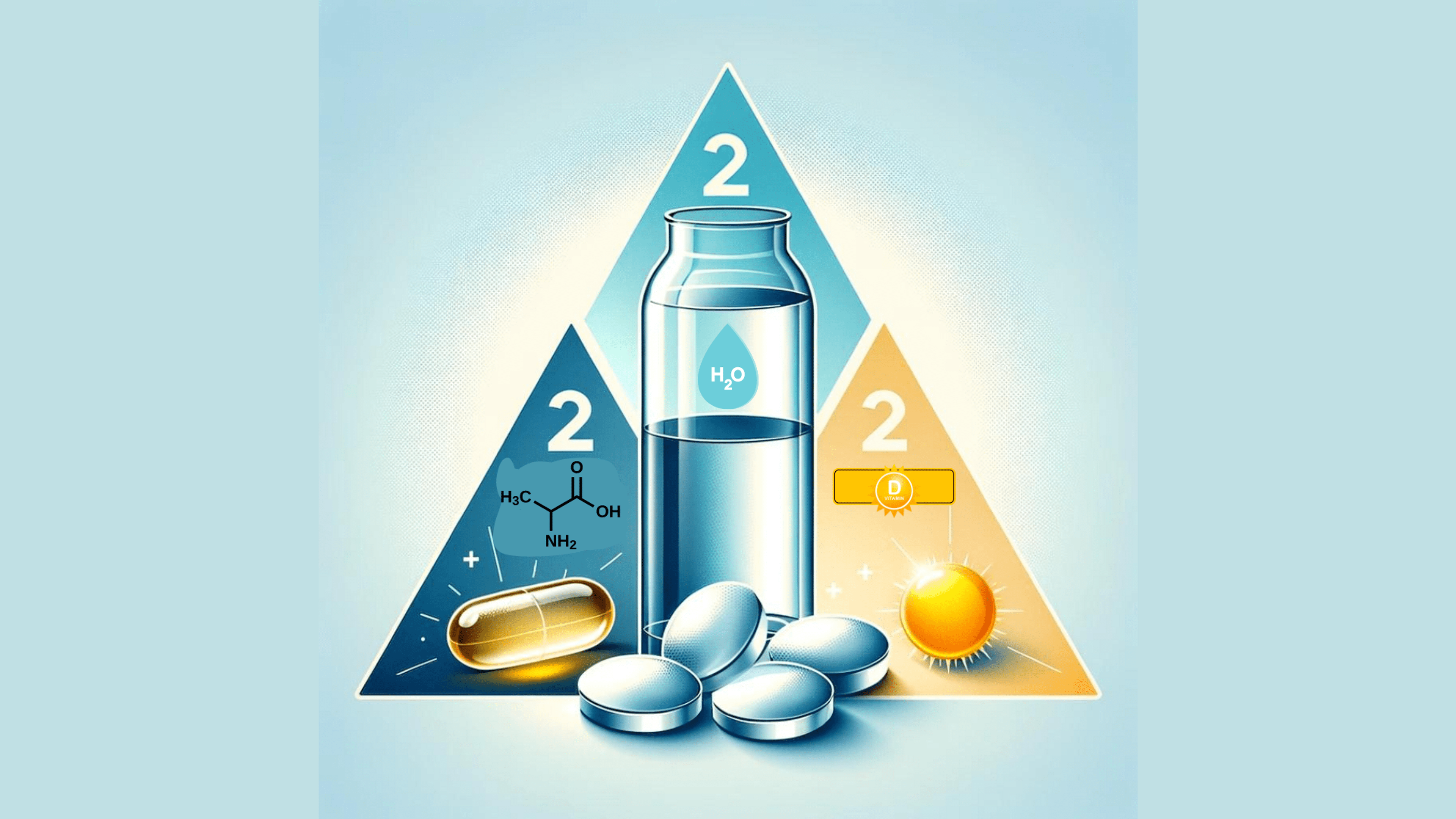What is the 2 2 2 Method for Metabolism?

Introduction to the 2 2 2 Method
As we delve into the fascinating world of health and nutrition, various approaches emerge, each with their unique perspectives and offers towards optimizing our health. One such method that has caught the attention of both health enthusiasts and experts alike is the 2 2 2 method. This approach is propagated as a tool designed to enhance our metabolic rates, which is vital for our energy synthesis and overall wellbeing. This introductory section will take you on an informative exploration of the 2 2 2 method's basic principles and how it purportedly aids in our metabolic functions.
Origins and Overview of the 2 2 2 Method
Principles Behind the Method
The principles behind the 2 2 2 method resonate with the understanding of how our bodies utilize different nutrients, and the benefits these specific constituents provide. Let's break it down:
-
Water intake: Water, as we know, is essential for most bodily functions. Like oil to a machine, water serves to lubricate our systems, aids in digestion, and promotes efficient nutrient absorption, which significantly contributes to enhanced metabolic rate.
-
Omega-3 intake: Omega-3 fatty acids, found abundantly in fish oils, are known for their anti-inflammatory effects. They play a pivotal role in cell function and health, which in turn reflects on how efficiently these cells can metabolize nutrients.
-
Vitamin-D3 intake: The inclusion of Vitamin-D3 is based on its promotion of bone health and regulation of insulin levels. By
maintaining insulin levels, the process of metabolism is optimized, preventing fluctuations that could disrupt efficient metabolism.
Expected Benefits for Metabolism
The anticipated benefits from the 2 2 2 method revolve around the aim of this approach - optimizing the metabolic functions. By ensuring hydration, providing necessary Omega-3 fatty acids, and regulating insulin via Vitamin D3, the body is equipped to perform nutrient metabolism more efficiently. This potentially translates into better energy synthesis and expenditure, thereby defining the metabolic rate.
Now having the foundational understanding of the 2 2 2 method, we can probe further into its implications in dietary practices, the scientific substantiations backing its principles, and its potential relevance in your health journey.
Breaking Down the 2 2 2 Method
The 2 2 2 method is a dietary guideline conceived with a focus on improvement and regulation of metabolic health. But what does it entails exactly?
The Significance of Each '2'
The well-thought numerology in the 2 2 2 method denotes frequency, balance and variety, all of which are vital in maintaining a healthy metabolism. Unpacked, each individual '2' carries the following message:
-
The first '2' dictates the consumption of at least 2 litres of water daily, prioritizing hydration, which is a crucial variable influencing metabolic rate. Water plays a quintessential role in nutrient transportation and bodily functions such as digestion and thermoregulation.
-
Next, encouraging the intake of at least 2 pounds of vegetables per day serves to not only lower overall caloric intake but also provides essential micronutrients and fibre that are pivotal for a well-functioning metabolism.
-
The final '2' in the commandment emphasizes the importance of 2 hours of physical movement each week. Exercise has been scientifically proven to elevate metabolic rate both during activity and in the recovery periods afterward.
Daily Dietary Guidelines
While the 2 2 2 method provides a fundamental guideline, understanding its application in daily nutrition should not be limited only to these principles. Recognizing the inherent complexity of dietary habits, it's vital to tailor the method to individual preferences, requirements, and lifestyle.
To better incorporate this method, consider the following recommendations:
-
Keep a variety of vegetables on hand to meet the 2-pound daily target. Be mindful of nutrient density when sourcing your produce, diversifying to fulfill a comprehensive micronutrient profile.
-
Consider both high-intensity and moderate physical activities to complete the 2-hour weekly exercise quota. This could range from resistance training and high-intensity interval training (HIIT) sessions to leisurely walks or yoga.
-
Drink water regularly throughout the day to complete the 2-litre guideline. Infuse water with fruits or herbs for those disinclined to the taste of plain water.
Complementary Lifestyle Changes
To bolster the benefits of the 2 2 2 method and promote long-term metabolic health, it's essential to complement this regime with supportive lifestyle choices. This means ensuring an adequate duration of quality sleep, adopting mindful eating practices, and regular stress management.
Sleep quality and duration greatly impact the body's metabolic functions such as glucose metabolism and appetite regulation. Aim for 7-9 hours of good sleep every night.
Mindful eating promotes an awareness of true hunger and satiety cues, fostering a healthier relationship with food. Take time to savour each meal and notice your body's signals.
Implementing stress management techniques like meditation, deep breathing exercises, or journaling can help manage chronic stress, an antagonist to metabolic health.
To wrap it all, the 2 2 2 method is a simplified rule-of-thumb aiming at optimizing your metabolic health by focusing on the three pillars of hydration, nutrition, and physical activity. Complementing this method with adequate rest, mindful eating, and stress management would provide a holistic approach towards long-term metabolic well-being.
Evaluating the Efficacy of the 2 2 2 Method
As we delve into the realm of metabolism-boosting strategies, it becomes crucial to objectively assess different methods for their effectiveness, benefits, and potential drawbacks. Among the myriad of methods proposed for improving metabolic health, the 2 2 2 method has generated considerable interest.
Scientific Perspective on Boosting Metabolism
When discussing the strategies to boost metabolism, there is a need to comprehend the scope and implications of relevant scientific research. A key to sustainable metabolic health is to facilitate the efficient burning of calories, even during periods of rest. A well-functioning metabolism can aid in weight management and promote overall wellbeing.
While the body's metabolic rate is largely determined by genetics, age, and body composition, certain lifestyle changes can offer modest improvements. Regular exercise, adequate hydration, consumption of protein-rich meals, and good sleep are some scientifically-backed strategies to maintain a healthy metabolic rate. However, novel methods like the 2 2 2 method warrant a closer scrutiny before their widespread adoption.
Pros and Cons of the 2 2 2 Method
The 2 2 2 method suggests consuming 2 cups of water, 2 tablespoons of apple cider vinegar, and 2 grams of cinnamon before each meal. Advocates of this method argue that it helps in curbing appetite, reducing blood sugar levels, and promoting weight loss.
However, it's important to remember that claims regarding the metabolic benefits of the 2 2 2 method rest primarily on anecdotal evidence. Scientific research on the impact of consuming apple cider vinegar and cinnamon on metabolism is limited and often inconclusive. Moreover, significant changes in metabolism essentially require a holistic approach that includes balanced nutrition, regular physical activity, and good sleep hygiene.
Furthermore, the direct ingestion of apple cider vinegar can potentially lead to gut discomfort and erode tooth enamel due to its high acidity. Cinnamon, though a healthy spice, can lead to allergic reactions in some individuals when consumed in high amounts.
Healthy Alternatives and Supplements
Looking beyond the 2 2 2 method, it's noteworthy that incorporating certain healthy habits and nutritional supplements can potentially facilitate metabolic health:
- Regular physical activity, especially strength training and high-intensity interval training, can enhance muscle mass, thereby increasing resting metabolic rate.
- Adequate hydration can temporarily spike metabolism. Drink clear, fresh water often, especially before meals.
- Consuming small, frequent meals can keep metabolism active.
- Incorporating protein-rich foods in the diet can result in a small increase in the metabolic rate due to the thermal effect of food.
- Certain spices like chili peppers contain capsaicin, which can offer a temporary boost to metabolism.
- Coffee and gree
n tea have been studied for their potential to slightly improve metabolic health.
- A good night's sleep is essential as disrupted or inadequate sleep has been linked with metabolic irregularities.
In conclusion, while the 2 2 2 method might serve as a supplementary approach to metabolism-boosting, a healthy lifestyle encompassing a balanced diet, regular physical activity, adequate hydration and good sleep remain the pillars of sustainable metabolic health. Prioritising these core strategies is likely to result in better health outcomes in the long run. Further research is necessary to validate and understand the benefits and potential limitations of methods like the 2 2 2 regimen.
In Summary
In this blog post, we explored the 2 2 2 method, its principles, implications, and its potential relevance to the optimization of metabolic health. We understood that this method proposes a daily consumption of 2 litres of water, 2 pounds of vegetables, and encourages at least 2 hours of physical exercise per week. Combined with additional tailored dietary habits and lifestyle changes, such as getting quality sleep and managing stress, this regimen aims to provide a balanced approach to sustainable metabolic well-being.
However, while the method offers a structured approach with potential benefits, it's paramount to note that your metabolic health fundamentally depends on a variety of factors, including genetics, age, and lifestyle.
Plan of Action
Implementing the 2 2 2 method can act as a guideline to boost your metabolic health, but it should be complemented by an overall healthy lifestyle for sustainable benefits.
Action Steps
To start incorporating the 2 2 2 method into your life:
-
Prioritize hydration by aiming to drink at least 2 litres of water per day. If drinking plain water is challenging, try infusing it with fruits or herbs for enhanced flavor.
-
Increase your daily intake of vegetables. Aim for consuming 2 pounds of vegetables a day, keeping variety and nutrient density in mind.
-
Make sure to engage in at least 2 hours of physical activity per week. This can be achieved via high-intensity exercises like resistance training or more moderate actions like walking or yoga.
-
Complement this regimen with other lifestyle adjustments. Aim for 7-9 hours of quality sleep per night, practice mindful eating, and adopt regular stress management techniques.
-
Remember that everyone’s body is different. What works well for one person might not work as well for another. If you experience any discomfort or see no improvements after following the 2 2 2 method, consider consulting a healthcare professional or a dietitian for a personalized approach to your metabolic health.
Lastly, the science of metabolic health is evolving, and new insights may emerge over time. Approaches like the 2 2 2 method should be seen as a supplement to current metabolic boosting strategies, and not a replacement for proven practices like a balanced diet, regular physical activity, adequate hydration, and good sleep. Further research is necessary to expand our understanding and ascertain the benefits and potential limitations of methods like the 2 2 2 regimen.





